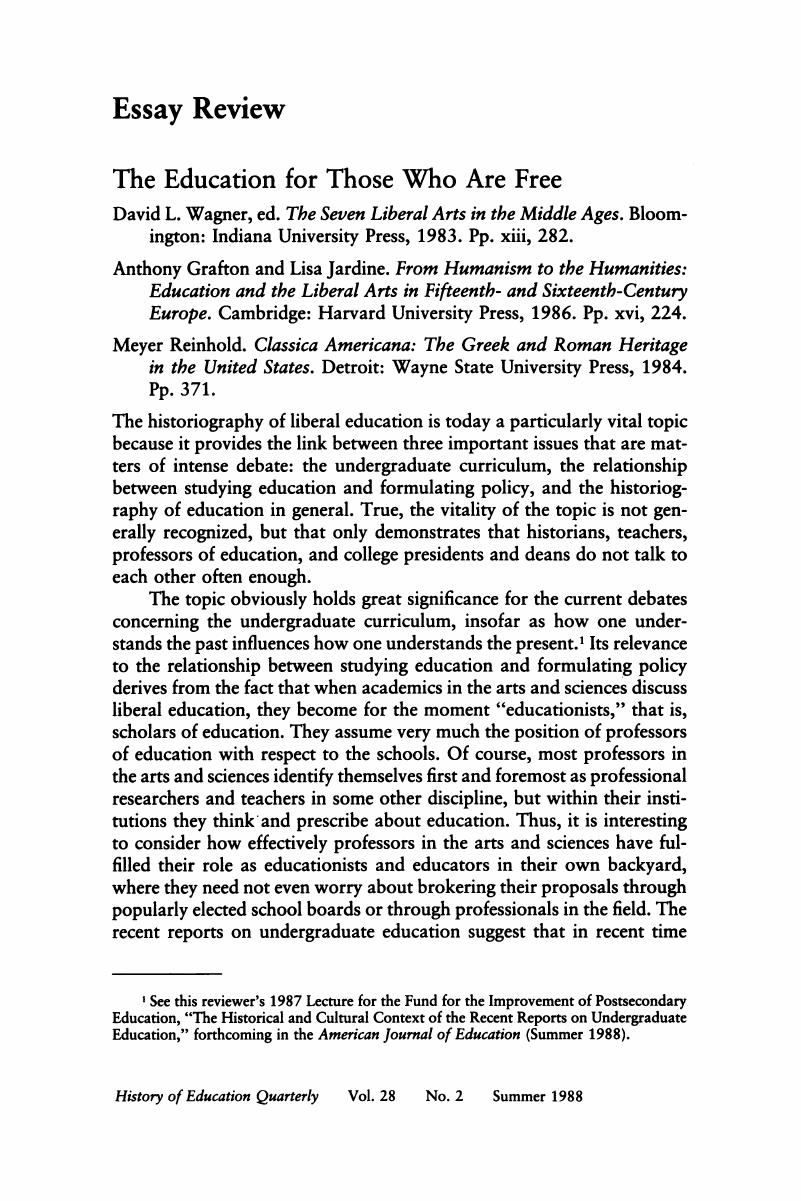Article contents
The Education for Those Who Are Free
Published online by Cambridge University Press: 24 February 2017
Abstract

- Type
- Essay Reviews
- Information
- Copyright
- Copyright © 1988 by the History of Education Society
References
1 See this reviewer's 1987 Lecture for the Fund for the Improvement of Postsecondary Education, “The Historical and Cultural Context of the Recent Reports on Undergraduate Education,” forthcoming in the American Journal of Education (Summer 1988).Google Scholar
2 Nevertheless, I do think that immaterial ideas and beliefs have some influence on the actions of human beings. Thus, it seems worthwhile to demonstrate, as I have tried to do, that historical debates about the term “liberal arts” have persistently addressed a fundamental epistemological problem concerning the relationship between reason and speech, which frames the related debates concerning curriculum, professorial role, institutional structure, and the purposes of living. Indeed the demonstrable continuity of this particular framework over time and across ethnic boundaries offers support for the proposition that the ideas and beliefs matter in some fundamental way, quite apart from the material interests that influence the choices made within the framework of debate about liberal education. Even if one could dismiss the evident persistence of the theoretical framework with Professor Engel's assertion that “the real issues in many debates about educational ideals often concern the allocation of resources and the arguments … are often no more than intellectual rationalizations for material interests,” it would at least be instructive, even important, to ascertain the nature of the derivative superstructure or Gramscian ideologies that are masking the “real” issues at stake in debates about liberal education. Hence, it is no less important to study the conceptions of what has been called “liberal education,” for example, than to weigh the material interests of those who conceived them. One cannot neglect the latter issue and claim to have written the whole story of liberal, or any other kind of education. But neither can one neglect the former. To do so leads, for instance, to the superficial and finally patronizing criticism, which is repeated by Professor Engel, among many others, that, since liberal education was instituted for those who enjoyed leisure—an elite—at the expense of the workers and slaves in an ancient society, it is irrelevant “in an era of mass higher education” in which most workers have leisure to study. (See Engel's review of Bruce Kimball, Orators and Philosophers: A History of the Idea of Liberal Education (New York, 1986), in History of Education Quarterly 27 [Fall 1987]: 389, 390.)Google Scholar
3 In the following, I am elaborating on comments I made in Educational Studies 16 (Spring 1985): 99–103.Google Scholar
4 Morrison writes, “The Fathers’ concept of the arts as media of symbolic disguise was rooted in their assumption that the religious world was a world of hidden meaning…. Convinced that they were dealing with concealed truths, in Scripture and in the arts, the Fathers had no difficulty in transferring secular incentives that had inflamed them in early life—motives of friendship and dominance—into spiritual ones” (pp. 38, 53).Google Scholar
5 Meliores esse grammaticos quam haereticos. Isidore, Sententiarum libri tres 3.3.11, in Patrologiae Cursus Completus Series Latina, ed. Migne, J. P. (Paris, 1850), vol. 83.Google Scholar
6 Cassiodorus, whom Masi cites for evidence, did draw elementary number theory from Boethius, but then wrote that arithmetic is studied in order to help with computational tasks and to heighten the appreciation of divine numbers. R. A. Mynors, ed., Institutiones (Oxford, 1937) II, iv, 7-8.Google Scholar
7 It is striking that Eugenio Garin receives most of their criticism, whereas Paul O. Kristeller, who is the foremost American interpreter of the Renaissance and whose interpretation comports with the traditional historiography, is cited but scarcely singled out for comment, let alone criticism.Google Scholar
8 Concerning the editing and production of the book, which was printed in Great Britain, one should commend the use of footnotes rather than endnotes and lament the strange weakness of the inking or print, which strains the eyes.Google Scholar
9 It should be noted that Grafton and Jardine are able to provide only the relatively few case studies that the sources will yield. In many instances, one or two such cases must carry the burden of representing an entire generation of the classrooms in a university, a city, or an entire nation. For another thing, even if such cases abounded, they would amount only to what the authors acknowledge to be “rhetorical induction: the weak form of argument that does not prove a thesis, but makes it more probable by supporting it with several cases in point” (pp. 177-78).Google Scholar
10 Lester J. Cappon, “Foreword,” in Bernard Bailyn, Education in the Forming of Amerian Society: Needs and Opportunities for Study (1960; New York, 1972), x; Grafton and Jardine, xi.Google Scholar
- 1
- Cited by


